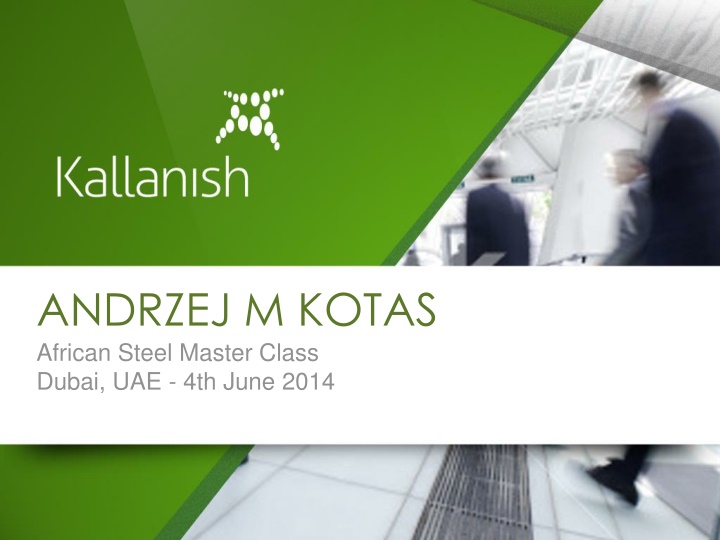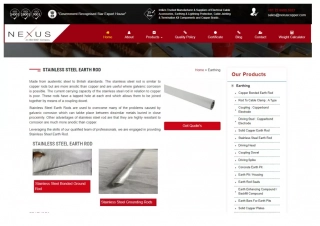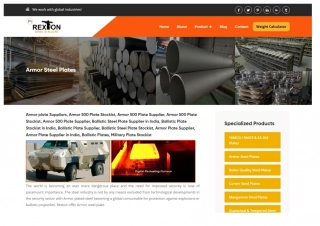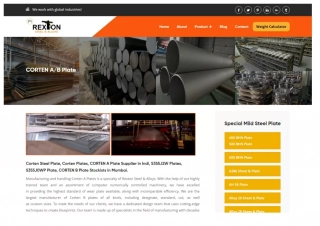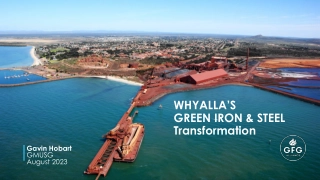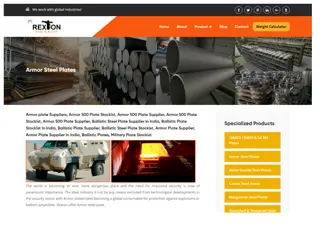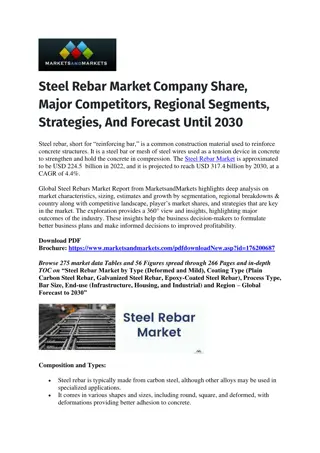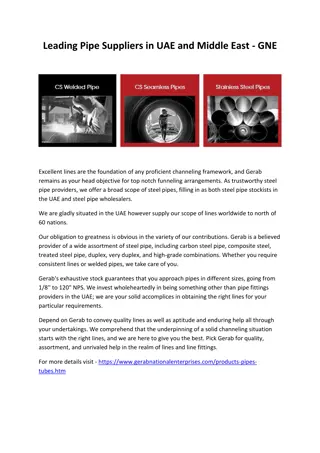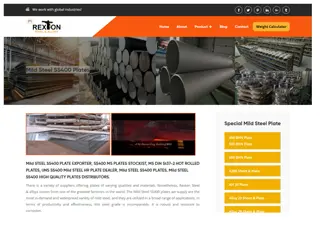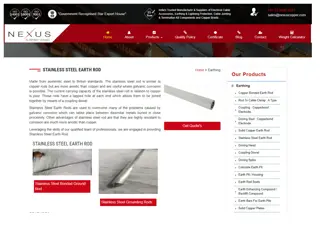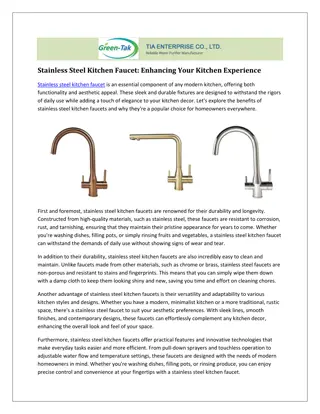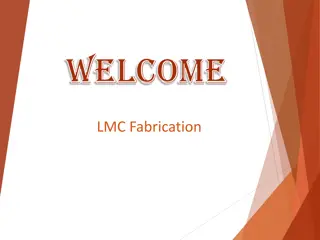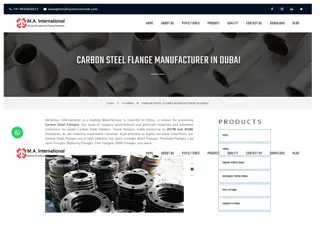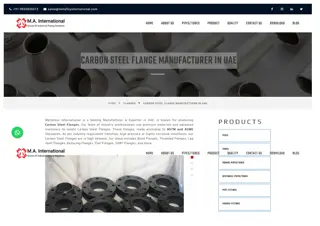Insights into African Steel Industry by Andrzej M. Kotas
Explore the African steel industry through the expertise of Andrzej M. Kotas, highlighting investment opportunities, competitive landscape, technological challenges, and industry evolution over the next 5 years. Learn why Africa presents unique opportunities compared to Europe due to little competition, underdeveloped demand, and low-cost inputs.
Download Presentation

Please find below an Image/Link to download the presentation.
The content on the website is provided AS IS for your information and personal use only. It may not be sold, licensed, or shared on other websites without obtaining consent from the author.If you encounter any issues during the download, it is possible that the publisher has removed the file from their server.
You are allowed to download the files provided on this website for personal or commercial use, subject to the condition that they are used lawfully. All files are the property of their respective owners.
The content on the website is provided AS IS for your information and personal use only. It may not be sold, licensed, or shared on other websites without obtaining consent from the author.
E N D
Presentation Transcript
ANDRZEJ M KOTAS African Steel Master Class Dubai, UAE - 4th June 2014
Andrzej M Kotas African Steel Investment Opportunities
Contents Introduction Why Africa? Competitive landscape Challenges of technology and quality Steel costs - raw materials, labour, energy Steel prices Investment opportunities Industry evolution the next 5 years
Introduction Andrzej Kotas steel expert of ~25 years MD of Metals Consulting International Ltd Founder of http://www.steelonthenet.com Steel industry specialist: restructuring, investment planning, feasibility studies Central & Eastern Europe, 20 years ago Middle East, 10 years ago 2014, East & West Africa (today s focus)
Why Africa? AFRICA EUROPE Little competition Underdeveloped demand3 Few capex controls Tariff protection Low cost inputs Steel overcapacity1 Stagnating market2 BAT/emission controls CO2-related costs Energy & labour cost 1: OECD in December 2013 noted a current excess of global steelmaking capacity of over 300 million tonnes 2: EU market decline since 2007 peak has been ~25% in tonnage terms 3: Steel demand in many parts of Africa is still ~30 kg/capita versus ~200 kg/capita worldwide
African production is often technologically behind1 Competitive landscape (1) Average West European economy Integrated and EAF-based steelmaking with CC One or two large 2-3 mt/year steelmakers making HRC Perhaps two 1 mt/yr cold rollers / HDG producers Perhaps two or three 1 mt/yr long product plants [bar, rebar] with some special steel e.g. SBQ Typical African economy Only scrap-based steelmaking. Mostly very small steelmakers each with 40-50kt steel capacity No HSM or H/S mills. Maybe 1-2 reversing CRMs <125kt Many small rebar producers ~40kt/year each No special steel 1: Thus, ingot shops are common. Rebar is twisted rather than thermo-mechanically treated and often cold-drawn.
Angola & Nigeria have similar capacity profiles Competitive landscape (2) # Facilities Steel Plate HRC CRC Coated H/S LL W Tube Kenya 9 0 0 2 1 0 12 7 Tanzania 2 0 0 1 1 0 2 2 Uganda 3 0 0 1 1 0 5 1 Total 14 0 0 4 3 0 19 10 Average plant size, kt 40 n/a n/a 85 70 n/a 40 30 Local industries are dominated by small-scale steelmaking and production of light long products [mostly rebar] Analysis is at end-2013. Figures shown are production capacities / year. HRC denotes hot rolled coil, CRC is cold rolled coil, H/S is heavy sections and LL is light long products.
Competitive landscape (3) These differences have certain supply-side implications Semi-finished imports often significant Indigenous raw materials such as iron ore and coal often unused1 Competition often non-existent Downstream production often very fragmented and very small-scale2 1: Large scale facilities producing several million tonnes / year of steel via BOF-based steelmaking usually cannot be justified by market size 2: In some parts of East or West Africa, it will be quite normal to find a half a dozen firms supplying a 500 kt/year rebar market. In Europe, a market of this size would be served by a single steelmaker
Challenges - technology African environment better lends itself to different steelmaking technology Lack of a well-developed grid and frequent power outages mean that induction furnace- based steelmaking is often preferred to EAF steelmaking Induction furnace scale of ~20-40kt/year also better suited to the smaller market size This gives significant capex advantages1 1: An average size 650 kt/year EAF will involve ~$110m of capex. An average 40 kt/year IF may cost just $4m
Challenges quality (1) Quality of African-produced steel is sometimes below that of Western standards Rebar in particular, is often locally produced as a low tensile- strength product1 This explains the existence of a significant import market for British Standard rebar Standards development represents a real opportunity for local investment 1: In Nigeria for example, Nigerian standard rebar cannot be used for construction of multi-storey buildings. BS4449 rebar is imported instead. For discussion see http://www.vanguardngr.com/2011/01/new-standard-for-steel-industry/. Similar rebar quality issues arise in other countries http://news.nationalgeographic.com/news/2013/13/130425- bangladesh-dhaka-building-collapse-world/
Challenges quality (2) Chart shows a recent analysis of rebar quality in Nigeria TMT quality (BS4449) was all imported TMT rebar commands a ~10% price premium1 The quality issue offers an investment opportunity TMT rebar is equivalent to BS4449 rebar in chart above The demand trends are to greater use of better quality steel 1: On a 250kt rebar mill, this premium alone would provide additional revenue of $15m / year if rebar sells at $600/t
The story so far Many countries in East or West Africa can be characterised in terms of under-developed demand & little competition Technology is often dated Quality can be below international norms This creates many supply-side opportunities underpinned by evolving demand1 How about the industry economics? 1: Meaning greater steel volumes, broader product mix, with steel produced to higher standards.
Steel costs raw materials (1) Africa is known to have abundant reserves of iron ore Typical selling price iron ore lump: $150/tonne1 Typical excavation cost: $50/tonne2 Infrastructure and mine development costs will be significant, but over time, African iron ore mining should develop into a colossal cash cow 1: Typical international price in 2013, 65% Fe content, fob basis 2: See http://www.steelonthenet.com/kb/iron-ore-extraction-costs-2013.html
Steel costs raw materials (2) Ferrous scrap remains a dominant steel making raw material in many parts of Africa Scrap export bans in COMESA countries and in ECOWAS mean that the scrap price is sometimes [not always] $100 or more below the international market price Illicit scrap trade is non uncommon
Steel costs raw materials (3) Chart shows an analysis of 2013 scrap-based liquid steelmaking costs in West Africa Scrap is a dominant cost but priced at $250/t not $375/tonne This has major impact on steelmaking economics Scrap availability is often also an issue1 1: I suggest a drive around Luanda. The Angolan capital is littered with automotive carcasses suburbs also
Steel costs - labour 1 Some African labour costs are ~10% of those in the EU Productivity is much worse On a workforce of 250, an employer can nonetheless save $2.5m per year Restrictive practices as in some parts of EU don t arise 1: Chart adapted by MCI from https://www.destatis.de/EN/PressServices/Press/pr/2013/03/PE13_116_624.html
Steel costs energy (1) World (and African) electricity prices per unit highly variable Nigeria is low cost, Ghana is high cost Congo HEP could radically reduce future electricity costs Nigerian costs assume in-house power generation from low- cost gas. Ghana costs assume own sub-station. 1: Source: KPMG report Economic analysis in relation to the Latvian obligatory electricity surcharge November 2012 2: Construction of Congo s Grand Inga HEP project is scheduled to start in 2016. See http://guardianlv.com/2014/04/worlds-biggest-hydro-power-project-bigger-than-chinas-three-gorges-in-africa-given-go- ahead-by-world-bank/
Steel costs energy (2) Other fuel costs also show much variability across Africa Nigeria has very low cost gas Angola also has favourable fuel oil prices Region Fuel Price World Fuel oil Nat gas $14/GJ $17/GJ Nigeria Nat gas $4/GJ Fuel oil Nat gas Angola $10/GJ Offshore oil and gas exploration is currently underway on East African coast
Steel prices (1) One of the most attractive aspects about steel investment in Africa is the import tariff on imported finished steel goods Such import tariffs are imposed both by ECOWAS and by COMESA, with WTO approval1 The tariffs radically transform steelmaking profitability 1: MCI understand that the purpose of these tariffs is to encourage indigenous producers to invest in new capacity, thus benefiting employment and the balance of trade.
COMESA import tariffs, 2014 Steel prices (2) Product Tariff Semi-finished steel Billet 0% For example, COMESA import tariffs are up to 25% On a tonne of HDG sheet costing $850/tonne, the tariff amounts to over $200/tonne This is all incremental profit ABOVE normal returns you would expect to make elsewhere in the world1 Slab 0% Flat products Hot rolled plate 0% Hot rolled coil & sheet 0% Cold rolled coil & sheet 10% Hot dip galvanised sheet 25% Organic coated coil & sheet 25% Long products Heavy sections 0% Light sections 10% Rebar 10% Wire rod 10% Steel wire 10% Tube products Welded tube Source: WTO 25% 1: Not surprisingly, capacity structure in many parts of Africa parallels the tariffs with much downstream investment in HDG, OCS and rebar; but very little in H/S, plate or HRC.
Steel prices (3) On zero-tariff products, a price premium exists also in many parts of Africa This is transport cost related Consider a country such as Mozambique Nearest large suppliers of HRC will be in South Africa, India, Korea, Japan with a transport cost of ~$75/tonne As a [notional] monopoly producer of HRC in Mozambique, this premium is yours to take
Economic summary (1) Consider production of rebar in a medium- sized ECOWAS or COMESA country The chart overleaf summarises the main African price / cost distortions compared to average EU steelmaking economics1 1: Main assumptions are scrap based production of rebar at a scrap price of $375/t [$250/t in Africa]; EAF or IF steelmaking; African labour costs per tonne at ~40% EU levels; African fuel oil / gas costs at 85% of EU levels; African electricity prices 50% higher than EU levels; and a 10% import tariff on rebar otherwise priced at ~$600/t. MCI rebar cost model predicts a resulting profit of $42/t in Europe and $273/t in Africa.
INDICATIVE Economic summary (2) Factors Behind Greater African Steel Company Profitability 250 200 Difference, $ / tonne 150 100 50 0 Scrap Yield Energy Labour Other Depreciation Price prem Profit -50 Cost model predicts African steelmaking with profit ~$230/tonne better than Europe Lower scrap price and the tariff-related price premium are 1 factors behind this difference
Economic summary (3) In reality, profits of $230/tonne on production of rebar etc are unlikely to last Illicit scrap export will take place, and scrap will become more difficult to come by Competition will also reduce actual prices available to local suppliers With a small scrap cost advantage of even $25/tonne and a small price premium, a surplus profit approaching $100/tonne is nevertheless not impossible, improving average profitability from ~$40/tonne to ~$140/tonne1 1: This is of course just a notional example
Reality check Why is nobody investing in Europe? Where are the consulting opportunities? Downsides of investing in Africa? Who will be the Mittal of Africa? These topics will be open for later discussion
Investment opportunities Scrap collection - strategic TMT rebar standards driven Welded tube1 Production of steel rail2 Evolution long to flat (LISCO, QASCO, Ezz) The first one million tonner 1: Note importance of oil & gas in Nigeria and in the medium term in Tanzania, Mozambique etc. Note also however the import tariff of 25% 2: There is no rail network in Iraq, Oman, Yemen or Oman. How about construction of LAPSSET (or even of the East- West trans-African rail route) ? Who is to supply this rail?
Industry evolution next 5 yrs Consolidation of rebar production / large increase in average plant sizes Entry into new OCS, CRC, HRC production Greater use of DRI / pig iron / Corex1 Large-scale import displacement Much foreign investment from Asia-Pacific; probably Europe as well 1: This will be driven by increasing availability of iron ore, as also by future scrap shortages
Next Steps For further discussion about steel sector investment in Africa please contact: Andrzej M Kotas, Managing Director Metals Consulting International Ltd Website: http://www.steelonthenet.com Email: MCI@steelonthenet.com or call +44 775 149 0885
